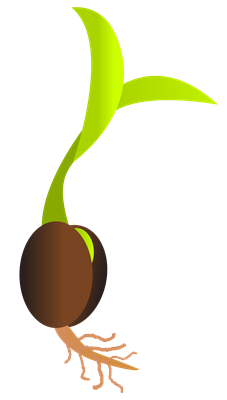
Investigation: What Factors Affect Seed Germination?
Introduction
In the spring, flowers begin to bloom and you may see sprouts in the garden. How do plants know when it's spring and when to grow? If a seed grew too early, it might be exposed to a harsh cold environment. If it grew too late, it might not have enough water to survive. The process by which an organism grows from a seed into a plant is called germination. The seed of a plant is the embryo, and it contains enough energy for the plant to survive until it is time to start growing. In some cases, these seeds can survive for years.
What triggers the seed to start growing? It varies by plant and by the environmental conditions where the plant grows. The giant sequoia trees of California require fire to germinate. This adaptation ensures that new trees will grow when there is an opening created by the death of other trees. If the seeds germinated without fire, the seedlings would be too shaded to grow.
Not all plants need fire to start growing, but most do take the cues from the environment. In this activity, you will investigate factors that can affect the germination of a seedling.

Part 1: Consider a Question / Hypothesis
Several variables might affect the germination, these variables include: light, temperature, water, soil type, air quality.
Choose ONE variable to investigate. Write a hypothesis below. Remember, that the hypothesis should be a complete sentence that can be tested.
Part 2: Design an Experiment
With your lab group, determine how you could test the variable.
What kind of data will you gather? Will you have a control group? What kind of materials or equipment will you need? How many seeds will you use?
Available Materials ( other materials may be available, check with your instructor): radish or bean seeds, ziploc bags, paper towels, window/sunlight, water, vinegar, soil, refrigerator
Sketch or describe your experiment below. Your instructor will approve your plan before you set it up.
Part 3: Gather Data
Most seeds will germinate in a few days. Plan to make observations over the next few days and organize your observations below. Be as detailed as you can about what you see.
Part 4: Publish Your Results
Create a lab report or infographic that includes the following information from this investigation. You have written things down on this paper, now it is time to organize the information into a formal report. This report should include four detailed sections.
1. Introduction: includes background information about the lab and your hypothesis
2. Experimental Design: include a drawing and/or description of how you set up your experiment
3. Data: Organize observations into a data table
4. Conclusions: Use your data to answer the experimental question. Be specific in how you write this, your conclusions must follow your data, even if they didn't turn out as you were expecting.
5. Reflection: In this section, discuss how your results may provide insights into how the environment can affect plants in general and how this information can be useful to humans. For example why would farmers need to consider germination factors when planting crops?
| Lab Report Rubric | Excellent 3 pts | Good - 2 pts | Needs Work - 1 pt |
| Question/Hypothesis | written as a complete sentence, question is restated as a prediction that can be tested | Unclear phrasing, does include at least one question and answer | question is not answered, hypothesis not stated in a way that can be tested |
| Design | the procedure will accurately test the hypothesis, can be followed easily, materials listed or described | procedure does test the hypothesis, parts are unclear or may not fully test, some materials are listed | procedure likely will not test the hypothesis as stated, procedure unclear, materials not listed |
| Data | Clearly shows the all results of the experiment and includes a time frame, descriptors and any quantitative data taken, well organized, | Shows some results with some time frame and descriptors, organization lacking or hard to follow | results missing, hard to follow, only addresses part of the experiment, lack of organization |
| Conclusions | Summarizes the essential data used to draw conclusions; conclusions follow data (not wild guesses or leaps of logic), the experimental question is answered | Summarizes data, answers some of the experimental questions, includes a reference to the data | Does not answer question or summarize data, does not follow data or contains major errors in reasoning |
| Reflection | Provides a thoughtful opinion about how this information can be useful to scientists, farmers, or humans | Attempt to reflect upon the experimental results and its uses | Does not provide coherent reflection |
 Other Lessons on Plants
Other Lessons on Plants
Investigation – Rate of Photosynthesis – using baking soda, elodea and light, measure the bubbles to observe how fast a plant photosynthesizes and releases oxygen
Investigation – Algae Beads and Photosynthesis – use algae cultures and sodium alginate, measure photosynthesis by changes in color of indicator
Investigation: Photosynthesis – this lab uses leaf disks that float to indicate photosynthesis. Students investigate factors that affect photosynthesis. (AP Lab)
Investigation: Photosynthesis and Plant Growth (virtual) – use a virtual app to show how plant growth changes in response to light color and light intensity
Investigation: Separation of Plant Pigments – use chromatography to show how leaves contain pigments that separate

